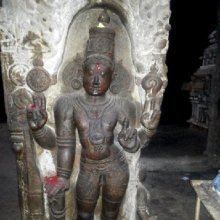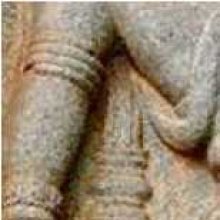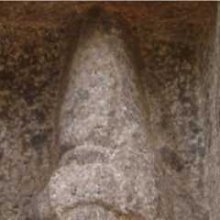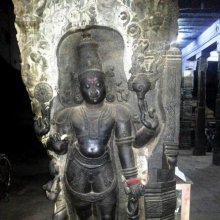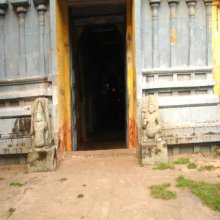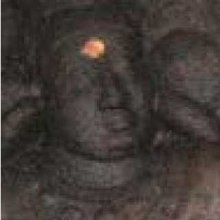Dvarapalaka, Dvārapālaka, Dvara-palaka: 10 definitions
Introduction:
Dvarapalaka means something in Hinduism, Sanskrit. If you want to know the exact meaning, history, etymology or English translation of this term then check out the descriptions on this page. Add your comment or reference to a book if you want to contribute to this summary article.
Images (photo gallery)
(+36 more images available)
In Hinduism
Pancaratra (worship of Nārāyaṇa)
Source: SriMatham: Vaiṣṇava Iconology based on Pañcarātra ĀgamaThe eight door-keepers of Vaikuntha (dvāra-pālaka) are known as
- Dhāta & Vidhāta (East),
- Bhadra & Subhadra (South);
- Nanda,
- Sunanda (North);
- Jaya & Vijaya (West).
Sometimes Nanda and Sunanda are replaced by Caṇḍa and Pracaṇḍa.

Pancaratra (पाञ्चरात्र, pāñcarātra) represents a tradition of Hinduism where Narayana is revered and worshipped. Closeley related to Vaishnavism, the Pancaratra literature includes various Agamas and tantras incorporating many Vaishnava philosophies.
Vastushastra (architecture)
Source: Shodhganga: Temples of Salem region Up to 1336 ADDvārapālaka (द्वारपालक).—Dvārapālakas are the door-keepers of the temples, and sculptures representing them are noticed invariably in all the temples. The sculptures of these Dvārapālaka are found carved both in relief as well as in the round. They are always carved in pairs. The forms of these sculptures closely resemble those of the main deity.
Hands: They are four-handed and the attributes they carry vary based on the creed to which they belong. The Śaiva-Dvārapālakas hold the trident and the kettle drum in their upper hands and the Vaiṣṇnava-Dvārapālakas hold the conch and the discus in their upper hands. The mace is common for the Dvārapālakas of both the creeds, which is held in their lower left hand. Their lower right hand is disposed in various gestures like the tarjanimudra, abhayamudra and svargahasta. But the commonly found gesture is the tarjanimudra.
Faces: Their faces are shown as ferocious, and they wear a kirīṭa, which is occasionally shown with a halo of flames. The ferocity of the face is shown by the carving of the prominent canines.
Legs: They are shown as standing with one of their legs firmly placed on the ground while the other leg is lifted across the other leg and shown as resting upon the mace. The left leg of the Dvārapālaka to the left side of the doorway is shown is lifted while the right leg of the Dvārapālaka to the right side is shown as lifted. This is a posture common in Tamil idiom, whereas the Dvārapālakas in the Karnataka idiom is sometimes shown in tribhaṅga or dvibhaṅga.
The Texts prescribe that the Dvārapālakas have to be provided for all the doorways of all the four directions. Dvārapālakas are found carved at the doorway of the gūḍhamaṇḍapa. They are sometimes carved on the pedyas of the dvārabandha. They are even found in the mahādvāras of the temple.

Vastushastra (वास्तुशास्त्र, vāstuśāstra) refers to the ancient Indian science (shastra) of architecture (vastu), dealing with topics such architecture, sculpture, town-building, fort building and various other constructions. Vastu also deals with the philosophy of the architectural relation with the cosmic universe.
Arthashastra (politics and welfare)
Source: Shodhganga: Kakati Ganapatideva and his times (artha)Dvārapālaka (द्वारपालक, “door keeper”) is an official title designating one of the seventy-two officers (niyoga) of the Bāhattaraniyogādhipati circle, according to the Inscriptional glossary of Andhra Pradesh (Śāsana-śabdakośāmu). The bāhattaraniyoga-adhipati is the highest executive officer of this circle (including a Dvārapālaka). For example: During the reign of Gaṇapatideva, the area extending between Pānagal to Mārjavāḍi was entrusted to Gaṇḍapeṇḍāru Gangayasāhiṇi as Bāhattaraniyogādhipati. Later on, this office was entrusted to Kāyastha Jannigadeva.

Arthashastra (अर्थशास्त्र, arthaśāstra) literature concerns itself with the teachings (shastra) of economic prosperity (artha) statecraft, politics and military tactics. The term arthashastra refers to both the name of these scientific teachings, as well as the name of a Sanskrit work included in such literature. This book was written (3rd century BCE) by by Kautilya, who flourished in the 4th century BCE.
Purana and Itihasa (epic history)
Source: archive.org: Shiva Purana - English TranslationDvārapālaka (द्वारपालक) refers to “one who stands at the gate”, according to the Śivapurāṇa 2.4.14 (“The Gaṇas argue and wrangle”).—Accordingly, as Brahmā narrated to Nārada: “The infuriated Gaṇas of Śiva at his bidding went there and questioned the son of Pārvatī who stood at the gate (dvārapālaka). Śiva’s Gaṇas said:—‘Who are you? Whence do you come? What do you propose to do? If you have a desire to remain alive go away from here’”.

The Purana (पुराण, purāṇas) refers to Sanskrit literature preserving ancient India’s vast cultural history, including historical legends, religious ceremonies, various arts and sciences. The eighteen mahapuranas total over 400,000 shlokas (metrical couplets) and date to at least several centuries BCE.
General definition (in Hinduism)
Source: Gaudiya History: Genealogy of the South Indian DeitiesDvārapālakas are the doorkeepers of Śiva. Dvārapālakas are the guardians who stand watch near the door that leads to god. They would first inquire about which deities wished to come to god. After receiving [god’s] permission they would allow the deities to proceed to god. Those who want to proceed against the guardians’ will receive severe punishment. Bhairava is Īśvara himself. Among his 1,008 appearances he once appeared with the name Bhairava. It is also said that Bhairava is the protector of the mountain kailāsa. In addition, it stands also written that there are 80,000,000 Bhairavas. One would also bring offerings to them.
Languages of India and abroad
Sanskrit dictionary
Source: DDSA: The practical Sanskrit-English dictionaryDvārapālaka (द्वारपालक).—a door-keeper, porter, warder.
-paḥ Name of Viṣṇu.
Derivable forms: dvārapālakaḥ (द्वारपालकः).
Dvārapālaka is a Sanskrit compound consisting of the terms dvāra and pālaka (पालक). See also (synonyms): dvāragopa, dvāranāyaka, dvārapa, dvārapāla.
Source: Cologne Digital Sanskrit Dictionaries: Monier-Williams Sanskrit-English DictionaryDvārapālaka (द्वारपालक):—[=dvāra-pālaka] [from dvāra > dvāḥ] m. door-keeper
[Sanskrit to German]
Sanskrit, also spelled संस्कृतम् (saṃskṛtam), is an ancient language of India commonly seen as the grandmother of the Indo-European language family (even English!). Closely allied with Prakrit and Pali, Sanskrit is more exhaustive in both grammar and terms and has the most extensive collection of literature in the world, greatly surpassing its sister-languages Greek and Latin.
Kannada-English dictionary
Source: Alar: Kannada-English corpusDvārapālaka (ದ್ವಾರಪಾಲಕ):—[noun] a man who guards the entrance of a building; a doorkeeper.
--- OR ---
Dvārapāḷaka (ದ್ವಾರಪಾಳಕ):—[noun] = ದ್ವಾರಪಾಲಕ [dvarapalaka].
Kannada is a Dravidian language (as opposed to the Indo-European language family) mainly spoken in the southwestern region of India.
See also (Relevant definitions)
Partial matches: Dvara, Palaka.
Starts with: Dvarapalaka Vimana.
Full-text: Dvarapala, Dvaragolla, Dvarika, Dvarapalika, Dvastha, Dvariga, Dvarapa, Dvaragopa, Dvaranayaka, Sumukha, Shrirangapattana, Sudeha, Candesha, Parivaralaya, Siddhi, Vetala.
Relevant text
Search found 4 books and stories containing Dvarapalaka, Dvārapālaka, Dvara-palaka, Dvāra-pālaka, Dvārapāḷaka, Dvāra-pāḷaka; (plurals include: Dvarapalakas, Dvārapālakas, palakas, pālakas, Dvārapāḷakas, pāḷakas). You can also click to the full overview containing English textual excerpts. Below are direct links for the most relevant articles:
Pallava period (Social and Cultural History) (by S. Krishnamurthy)
Crowns for Men (b): Karanda-makuta < [Chapter 4 - Material Culture of the People]
Head-dress of Men (Tiara) < [Chapter 4 - Material Culture of the People]
Bracelets (a): Separate bangles around each wrist < [Chapter 4 - Material Culture of the People]
Sculpture at its Best < [September-October, 1929]
Seats of Learning in Ancient India < [Jan - Feb 1939]
South Indian Portraits < [January, 1928]
The Religion and Philosophy of Tevaram (Thevaram) (by M. A. Dorai Rangaswamy)
Chapter 3.1 - Tripurantaka-murti (burning down of the three castles) < [Volume 2 - Nampi Arurar and Mythology]
Later Chola Temples (by S. R. Balasubrahmanyam)
Related products
